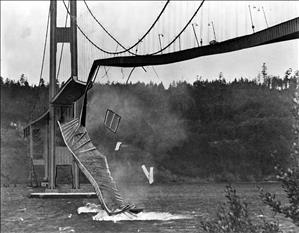On November 7, 1940, at about 11 a.m., the Tacoma Narrows Bridge collapses in a high wind. The bridge spanned the Tacoma Narrows, a deep, narrow section of Puget Sound that separates Tacoma from Gig Harbor and the Key Peninsula. The bridge collapses four months and seven days after it is dedicated. It had severely oscillated even as it was being built: Workers on the bridge sucked lemons to combat seasickness and dubbed it "Galloping Gertie." The structure's wave-like motions made it a thrill to drive across -- joyriders increased traffic on the bridge from the beginning -- but no one expected it to collapse. The bridge disaster was a tragedy for Tacoma, which lost the retail trade from Kitsap County and a connection to the Bremerton Navy Yard during the years of World War II. The engineering failure became a textbook case and revolutionized designs and procedures for building suspension bridges.
A Dream Come True
On July 1, 1940, a clear day with blue skies, some 10,000 people turned out for the dedication and opening of the bridge. Washington Governor Clarence Martin extolled the economic and military progress that it would spur. Tacomans saw the bridge as a dream come true -- it would open Tacoma to shoppers previously dependent on Bremerton, and enable access from Pierce County to the Bremerton Navy Yard. The bridge was slender (too slender as it turned out) and beautiful. The 2,800-foot span strung between the towers was the third longest span among the world's suspension bridges. "Everyone marveled," writes historian Murray Morgan, "at the gossamer grace of a structure so long" (South on the Sound).
People enjoyed Galloping Gertie tremendously. They would wait until the wind was "right," drive up to Tacoma Narrows, then wait in line to "ride the bridge." Everyone was sure it was safe. A bank put up a billboard on the Tacoma side, proclaiming itself to be just as safe as the bridge. (The day the bridge collapsed, the bank rushed to remove the billboard.)
A Lighter, Cheaper Bridge
An original design for the Tacoma Narrows Bridge was the work of Washington Department of Highway's leading bridge engineer, Clark Eldridge (1896-1990). But Eldridge's design was compromised when Washington State Highway Director Lacey V. Murrow took his estimate of $11 million to the federal government (the Public Works Administration), which agreed to loan Washington the money but only for a modified, cheaper bridge designed by Leon Salomon Moisseiff (1872-1943). Moisseiff was a renowned suspension-bridge engineer involved in virtually every suspension-bridge design in the United States during the 1920s and 1930s. He believed that suspension bridges could be built much lighter. Moisseiff modified Eldridge's design in part by removing the truss intended to stiffen the deck; "Galloping Gertie's" deck had no supporting truss and was upheld by steel girders that were a mere eight feet high. Not coincidentally, Moisseiff's design required considerably less steel and cost $4 million less to build. Eldridge remained in charge of construction.
No one thought the bridge would fail, but there were worries about its propensity to gallop. The wave-like motions of the bridge went up and down in the direction of the roadspan, and only during collapse did the bridge begin to move laterally. F. Bert Farquarson, a civil engineering professor at the University of Washington, began making measurements and suggesting design alterations to reduce the movement. He was present at the collapse, and his astonishment was as great as anyone's.
The Collapse
On the day of the collapse -- known as the Pearl Harbor of Bridge Engineering -- Gertie was galloping fast and hard. Leonard Coatsworth, a Tacoma reporter, was driving across the bridge with his dog Tubby in the car. Here is his account of what happened:
"Just as I drove past the towers, the bridge began to sway violently from side to side. Before I realized it, the tilt became so violent that I lost control of the car... I jammed on the brakes and got out, only to be thrown onto my face against the curb. Around me I could hear concrete cracking. I started to get my dog Tubby, but was thrown again before I could reach the car. The car itself began to slide from side to side of the roadway. On hands and knees most of the time, I crawled 500 yards or more to the towers... My breath was coming in gasps; my knees were raw and bleeding, my hands bruised and swollen from gripping the concrete curb... Toward the last, I risked rising to my feet and running a few yards at a time... Safely back at the toll plaza, I saw the bridge in its final collapse and saw my car plunge into the Narrows" (quoted in Tacoma Narrows Bridge Information Center).
Professor Farquarson was there doing his measurements and ran out and tried to save Tubby, but the dog bit him and he gave up the effort. Tubby was the only fatality.
The cause of the failure was solid girders, which took wind and acted like sails (girders with perforations would have let the wind pass through). Also, the bridge was not stiff enough or heavy enough to withstand the wind of the Tacoma Narrows.
The collapse terminated Moisseiff's career and he died less than three years later. Clark Eldridge, who accepted some of the blame, took work with a San Francisco contractor working for the U.S. Navy on Guam. At the outbreak of World War II, he was taken captive by Japan and became a prisoner of war for three and a half years. After the war Eldridge returned to Washington state and resumed work as a consulting engineer and contractor. The collapse reverberated as a personal tragedy in the lives of both men.
The second Tacoma Narrows Bridge, incorporating all lessons learned, was built in 1950.

